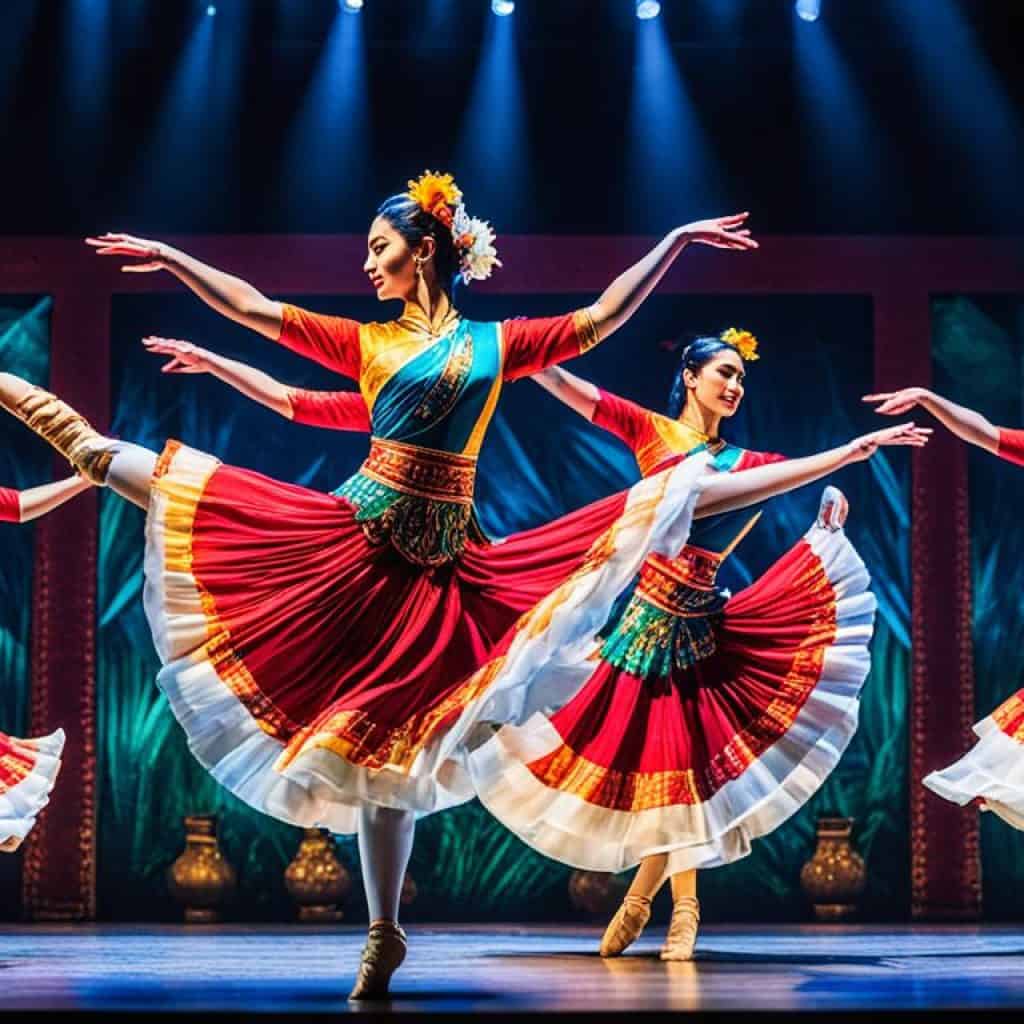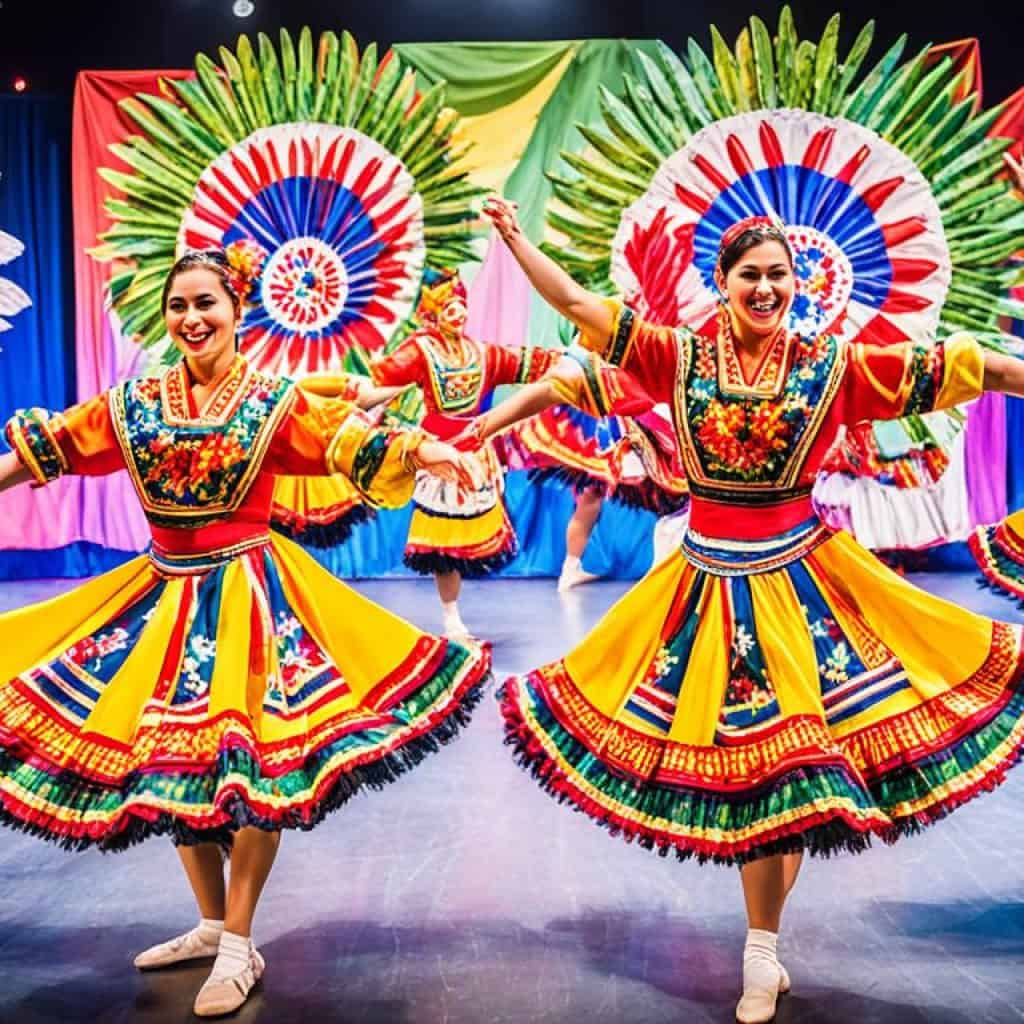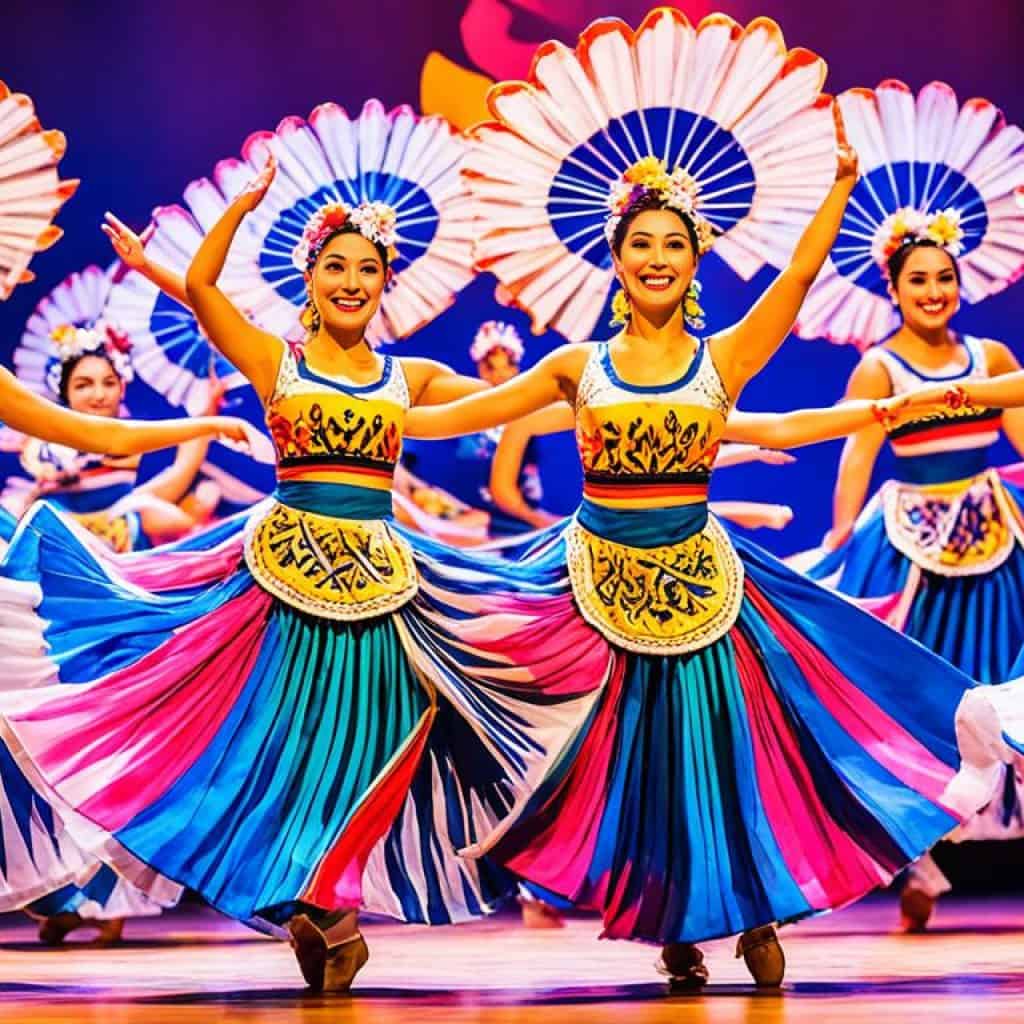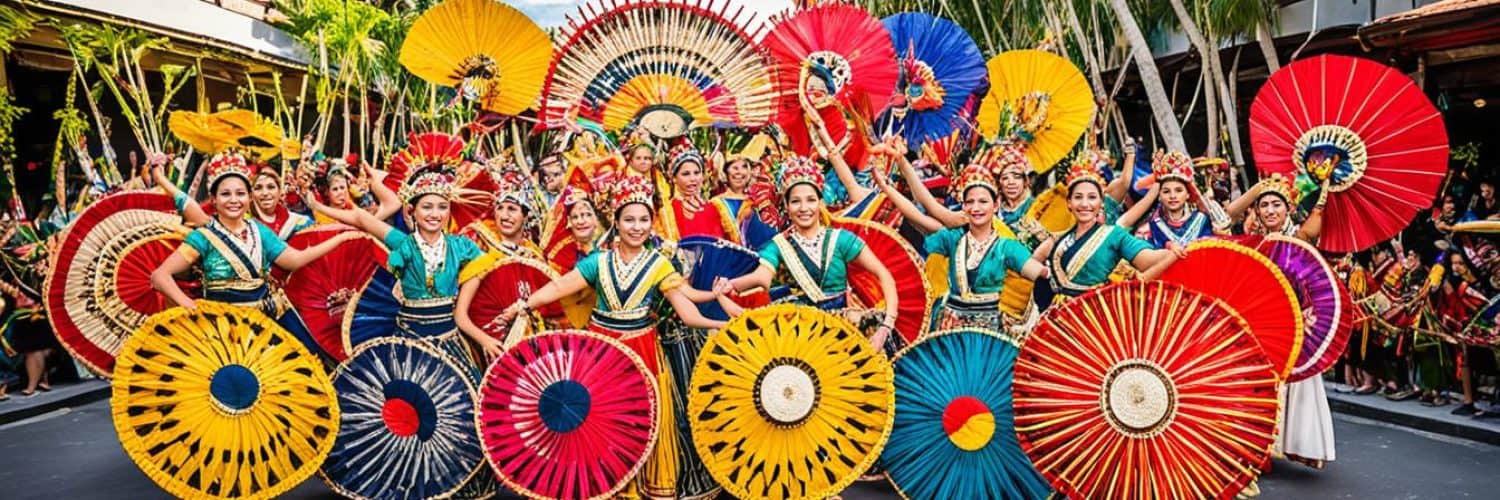Did you know that the Philippines is home to a rich tapestry of traditional dances that reflect its diverse cultural heritage? From the energetic and dynamic Tinikling to the graceful Pandanggo sa Ilaw, each dance carries its own unique history and significance.
In this article, we will take a journey through the vibrant world of ethnic dances in the Philippines, delving into the beauty and cultural diversity of these traditional art forms. Join us as we explore the different regions of the country and discover the captivating stories behind each dance.
Key Takeaways:
- Discover the cultural significance of Filipino ethnic dances.
- Explore the unique history and stories behind each dance.
- Appreciate the beauty and artistry of Philippine traditional dances.
- Learn about the values and traditions reflected in these dance forms.
- Celebrate the cultural diversity of the Philippines through its ethnic dances.
Tinikling – Philippine Folk Dance
Tinikling is a highly revered and energetic folk dance that is often hailed as the national dance of the Philippines. Originating from Leyte, this dynamic dance showcases the agility, coordination, and teamwork that are deeply ingrained in Filipino culture.
The name “Tinikling” is derived from the word “tikling,” which refers to a local bird known for its swift and agile movements. In this captivating dance, performers skillfully maneuver between clashing bamboo poles, imitating the fluid motions of the tikling bird.
The rhythm of the bamboo poles creates a challenging and fast-paced environment for the dancers. They must exhibit remarkable agility and coordination to avoid getting caught between the poles. Tinikling is a testament to the physical prowess and grace of the performers as they navigate this intricate dance form.
Tinikling also highlights the importance of teamwork in Filipino culture. Dancers must synchronize their movements and cooperate with each other to ensure a flawless performance. This dance fosters a sense of unity, cooperation, and harmony among its participants.
The Tinikling dance is not only a source of joy and entertainment but also serves as a powerful representation of the values and spirit of the Filipino people. Its vibrant and energetic nature captures the essence of Filipino culture, making it a beloved and iconic dance in the Philippines.
Pandanggo sa Ilaw – Philippine Folk Dance
Pandanggo sa Ilaw is a graceful dance that originated in Lubang, Mindoro. Performers balance oil lamps on their hands and heads while executing intricate footwork. This dance reflects the Spanish influence on Filipino culture, as it bears similarities to the Spanish fandango. Pandanggo sa Ilaw exudes elegance and showcases the resiliency and adaptability of the Filipino people.

“Pandanggo sa Ilaw is a beautiful dance that captivates audiences with its graceful movements and the mesmerizing glow of the oil lamps. It showcases the skill and agility of the performers, as they balance the delicate lamps while moving with precision. The fusion of Spanish and Filipino influences in this dance creates a unique and enchanting performance.”
Spanish Influence on Pandanggo sa Ilaw
The Spanish influence on the Philippines, which lasted for more than three centuries, profoundly impacted various aspects of Filipino culture, including dance. The Pandanggo sa Ilaw is a clear example of this influence.
The Spanish fandango, a lively and flirtatious dance, served as the inspiration for Pandanggo sa Ilaw. The fandango was a popular dance in Spain during the colonial period and was introduced to the Philippines by the Spanish colonizers.
Pandanggo sa Ilaw incorporates the elegant, graceful movements of the fandango, while adding its unique element of balancing oil lamps. The performers showcase their resiliency and adaptability as they manipulate the lamps, maintaining their poise and elegance throughout the dance.
Symbolism and Elegance in Pandanggo sa Ilaw
Pandanggo sa Ilaw is not only a visually captivating dance but also carries deeper symbolism. The oil lamps represent the light of tradition and culture that the Filipino people strive to preserve and pass on to future generations.
The delicate balance of the oil lamps on the performers’ hands and heads symbolizes the resilience and adaptability of the Filipino people in the face of challenges. It is a testament to their ability to navigate through life’s complexities with grace and poise, just like the dancers maneuvering through the intricate footwork.
Furthermore, Pandanggo sa Ilaw showcases the elegance and sophistication often associated with Filipino culture. The performers’ fluid and graceful movements captivate the audience, leaving a lasting impression of the beauty and artistry of the dance.
Pandanggo sa Ilaw: A Celebration of Filipino Heritage
Pandanggo sa Ilaw serves as a reminder of the rich and diverse cultural heritage of the Philippines. It highlights the fusion of Spanish and Indigenous influences, creating a uniquely Filipino dance that embodies the country’s history and resilience.
Through the graceful movements and the brilliant glow of the oil lamps, Pandanggo sa Ilaw celebrates the elegance and artistry of the Filipino people. It is a dance that showcases their resiliency, adaptability, and ability to find beauty in even the simplest of movements.
Next, let’s explore another mesmerizing Filipino folk dance, Singkil, which has its roots in the Maranao culture of Mindanao.
Singkil – Philippine Folk Dance
Singkil is a dance hailing from the Maranao people of Mindanao. It tells the story of the legendary Princess Gandingan as she gracefully navigates through a forest filled with swaying bamboo poles. Singkil mimics the princess’s escape from danger and embodies the grace, poise, and strong spirit of a Filipino woman. This dance is often accompanied by the mesmerizing sounds of kulintang, a traditional Muslim musical ensemble.
In the Singkil dance, performers gracefully step and dance between bamboo poles, symbolizing the agility and nimbleness of Princess Gandingan. The dance showcases the Maranao people’s deep appreciation for their cultural heritage and their connection to nature.
The Maranao people have preserved and passed down Singkil through generations, keeping their customs and traditions alive. The dance is a testament to the strength and resilience of the Maranao people, encapsulating their unwavering spirit and determination.
Singkil is a visual spectacle that captivates audiences with its intricate footwork, precise movements, and the princess’s beautiful costume. Through the delicate motions and gestures of the dancers, Singkil tells a story of bravery, grace, and triumph over adversity.
Cariñosa – Philippine Folk Dance
Cariñosa is a flirtatious and playful dance originating from the Panay region in the Philippines. This captivating dance is often performed during social gatherings and festivals, showcasing the charm, warmth, and hospitality of the Filipino people.
Dancers gracefully sway their handkerchiefs as they move with elegance and grace, engaging in courtship movements that symbolize the celebration of love and courtship. The Cariñosa dance is a testament to the rich cultural heritage of the Philippines, reflecting the joy and vibrancy of the Panay region.
With its flirtatious and lively nature, Cariñosa captures the attention of the audience, drawing them into the enchanting world of Filipino folk dances. The dance embodies the enchanting spirit of courtship and celebration, evoking a sense of joy and excitement among both performers and spectators.
Whether it’s the gentle swaying of the handkerchiefs or the intricate footwork, Cariñosa is a visual delight that highlights the creativity and artistry of Filipino dancers. It is a dance that embraces the beauty of love and courtship, using graceful movements to express emotions and create connections.
The Cariñosa dance not only showcases the talent and skill of its performers but also serves as a reminder of the hospitality and warmth that Filipinos are known for. It is through dances like Cariñosa that the importance of celebration, love, and connection is celebrated, fostering a sense of unity and joy within communities.
“Cariñosa is a dance of courtship and celebration, where dancers convey their feelings and emotions through the beauty of movement. It is a dance that radiates happiness and love, bringing people together in a joyful celebration of life.” – Local Dance Instructor
Join us as we continue our exploration of the diverse and captivating ethnic dances in the Philippines. In the next section, we will delve into the history and characteristics of the Maglalatik dance, which embodies the strength and history of the Filipino people.
Quick Facts
| Origin | Dance Style | Symbolism |
|---|---|---|
| Panay region, Philippines | Flirtatious and playful | Celebration of love and courtship |
 |
||
Maglalatik – Philippine Folk Dance
Maglalatik is a lively dance that originated from Rizal province in the Philippines. This dance vividly depicts a mock battle between two groups: the Moros (Muslims) and the Christians.
The dancers, adorned with coconut shell halves attached to their bodies, engage in rhythmic movements while skillfully striking the shells together. This rhythmic beat created by the coconut shell halves adds an energetic and captivating element to the dance.
Maglalatik symbolizes the historical struggle between the Filipino people and foreign colonizers. The dance serves as a powerful reminder of the courage, resilience, and tenacity of the Filipino people in overcoming adversity.
The mock battle portrayed in Maglalatik represents the tensions and conflicts between different cultural and religious groups that have shaped the history of the Philippines. It serves as an embodiment of the collective struggle for freedom and cultural identity.
Through Maglalatik, the dancers express their heritage, their history, and their determination to preserve their cultural traditions. The dance serves as a celebration of unity, resilience, and pride in the face of historical challenges.
Binasuan – Philippine Folk Dance
The province of Pangasinan is home to the captivating dance of Binasuan. This traditional Filipino dance showcases the exceptional skill and dexterity of its performers. Dancers gracefully balance glasses filled with rice wine on their heads and hands while executing intricate footwork with fluid movements. Binasuan requires precise coordination and agility, highlighting the grace and adaptability of the Filipino people.
The Art of Balance
Binasuan is known for its unique element of balancing glasses filled with rice wine. This impressive feat showcases the dancers’ ability to maintain seamless coordination and balance while executing intricate steps. The delicate movements and fluidity of Binasuan create a mesmerizing visual display, capturing the audience’s attention from start to finish.
A Showcase of Skill and Precision
Performing Binasuan requires a high level of skill and precision. The dancers must possess a strong sense of body control and a keen sense of timing to execute the complex footwork and fluid motions seamlessly. Every movement reflects the dancers’ dedication to their craft and their unwavering commitment to perfection.
“Binasuan is a testament to the Filipinos’ innate talent and their ability to excel in the performing arts.”
Celebrating Filipino Cultural Heritage
Binasuan is not only a captivating dance but also a celebration of Filipino cultural heritage. It embodies the values of discipline, perseverance, and grace that are deeply rooted in the Filipino identity. Through Binasuan, the country’s rich history and traditions are beautifully expressed, preserving the cultural heritage for generations to come.
| Key Features of Binasuan | Description |
|---|---|
| Skill and Dexterity | Binasuan showcases the exceptional skill and dexterity of the dancers as they gracefully balance glasses filled with rice wine. |
| Fluid Movements | The dance is characterized by fluid movements, creating a captivating visual spectacle that captivates the audience. |
| Coordination | Binasuan requires precise coordination between the dancers’ footwork, hand movements, and the balancing of glasses. |
| Grace | The dancers’ graceful execution of Binasuan reflects the elegance and poise of the Filipino people. |
Discover the captivating beauty of Binasuan, a dance that embodies the skill, grace, and cultural heritage of the Philippines.
Itik-Itik – Philippine Folk Dance
The Itik-Itik is a captivating and unique Philippine folk dance inspired by the graceful movements of a young woman named Kanang. Kanang, known for her extraordinary beauty and charm, imitated the elegant motions of a duck during a town fiesta. This dance incorporates delicate arm gestures, elegant footwork, and quick, sweeping steps reminiscent of a duck’s wading and flapping.
The Itik-Itik symbolizes the Filipino people’s deep connection with nature, particularly with the ducks commonly found in rice fields and bodies of water. Through this dance, the grace, agility, and fluidity of the ducks are celebrated, reflecting the harmonious coexistence between nature and the Filipino way of life.
The dancers of the Itik-Itik portray the quick and nimble movements of ducks, captivating audiences with their elegant and precise steps. The fluidity and grace exhibited in this dance showcase the agility and dexterity of the Filipino people, as well as their ability to adapt and thrive amidst the changing tides of life.
“The Itik-Itik is a dance that embodies the beauty of nature and the fluidity of life. It is a testament to the grace and adaptability of the Filipino people, just like the agile ducks gracefully gliding through rice fields and bodies of water.”
Pandanggo Oasiwas – Philippine Folk Dance
Pandanggo Oasiwas is a beautiful and rhythmic Philippine folk dance that originated from the coastal towns of Ilocos. This dance is deeply inspired by the gentle movements of ocean waves and the grace of birds in flight. As the dancers gracefully sway and swing their bodies, they mimic the ebb and flow of the waves while emulating the elegant flight of birds.
The fluid and gentle movements of Pandanggo Oasiwas reflect the close connection between the Filipino people and their natural surroundings. Just as the ocean waves and birds in flight are a part of the coastal towns of Ilocos, this dance is woven into the fabric of their culture, celebrating the beauty and tranquility of coastal life.
The word “oasiwas” translates to “sway” or “swing” in the Ilocano language, perfectly capturing the essence of this dance. The dancers depict the rhythmic sway of the ocean waves and the effortless grace of birds gliding through the air. Through their movements, they evoke a sense of harmony and unity with the natural world.
Pandanggo Oasiwas embodies the spirit of the Filipino people, who have always had a deep appreciation for the beauty and wonder of nature. This dance serves as a reminder of the importance of preserving our natural heritage and embracing the gentle and graceful movements that surround us.

Key Features of Pandanggo Oasiwas:
- Inspired by the gentle movements of ocean waves and the grace of birds in flight.
- Reflects the close connection between the Filipino people and their natural surroundings.
- Emphasizes the rhythmic sway and swing of the body.
- Celebrates the beauty and tranquility of coastal life in the towns of Ilocos.
- Evokes a sense of harmony and unity with nature.
Kuratsa – Philippine Folk Dance
The Kuratsa is a captivating Philippine folk dance that dates back to the Spanish colonial times. It showcases the intricate courtship and mating rituals of the crab, symbolizing the romantic nature deeply ingrained in Filipino culture. This dance is performed by a pair of dancers, who exhibit synchronized footwork, embellished with intricate arm gestures, hand clapping, and playful interactions. The rhythmic movements of the Kuratsa mirror the natural rhythms of nature, immersing the audience in a mesmerizing display of passion and romance.
Experience the allure and grace of the Kuratsa in this mesmerizing video:
La Jota Moncadeña – Philippine Folk Dance
La Jota Moncadeña, named after the town of Moncada in Tarlac province, is a lively and energetic traditional dance. It showcases the dynamic movements and intricate footwork that is characteristic of this captivating dance form. La Jota Moncadeña is known for its spirited performance, engaging the audience with its lively interactions and spirited spirit.
Dancers in La Jota Moncadeña skillfully combine grace, agility, and synchronization to create a visually captivating display. The intricate footwork and lively movements of the dancers reflect the energetic spirit of this dance. The use of castanets and bamboo poles adds a unique flair, enhancing the rhythm and excitement of the performance.
This traditional dance encourages interaction and harmony between dancers. The spirited performance of La Jota Moncadeña reflects the vibrant culture and lively nature of the Filipino people. It is a celebration of tradition, community, and the joy of dance.
Experience the Lively and Energetic Movements of La Jota Moncadeña
To truly appreciate the captivating nature of La Jota Moncadeña, one must witness the lively and energetic movements firsthand. The spirited performance, intricate footwork, and lively interactions between dancers make this dance a truly unforgettable experience.
“La Jota Moncadeña is a celebration of Filipino culture and heritage. It showcases the lively spirit and intricate artistry of our traditional dances.”
The La Jota Moncadeña holds a special place in the hearts of the people of Tarlac province. It is not only a testament to their rich cultural traditions but also a reflection of their vibrant and energetic spirit.
Celebrating Philippine Folk Dances with La Jota Moncadeña
La Jota Moncadeña is a delightful addition to the diverse repertoire of Philippine folk dances. Its lively and energetic movements, intricate footwork, and castanets create a joyful and spirited atmosphere. This dance embodies the rich cultural heritage of Tarlac province and serves as a testament to the Filipinos’ passion for dance and celebration.
“La Jota Moncadeña is a spirited and lively dance that embodies the vibrant culture and heritage of the Filipino people.”
Experience the vivaciousness of La Jota Moncadeña, and journey into the heart of Tarlac province through the infectious rhythm and energetic spirit of this traditional dance.
Kappa Malong-Malong – Philippine Folk Dance
Originating from the indigenous communities of Mindanao, the Kappa Malong-Malong is a captivating Philippine folk dance that showcases the cultural significance of the malong. This traditional garment is wrapped around the bodies of the dancers, creating a vibrant and flowing ensemble that reflects the rich heritage of the Mindanao region.
The Kappa Malong-Malong is characterized by intricate footwork, graceful arm gestures, and coordinated movements that demonstrate the fluidity of the malong. Dancers move with precision and elegance, embodying the spirit and traditions of the Mindanao indigenous communities.
With its colorful malongs, vibrant costumes, and mesmerizing choreography, the Kappa Malong-Malong is a testament to the cultural diversity of the Philippines. This dance form not only celebrates the artistic expression of the Mindanao indigenous communities but also showcases the unity and creativity that can be found within the Filipino culture.
Conclusion
The diverse and vibrant culture of the Filipino people is beautifully showcased through their traditional folk dances. These dances, such as Tinikling, Pandanggo sa Ilaw, Singkil, and more, carry with them a rich history and embody the values and artistic expression of the Filipino culture. Exploring these ethnic dances allows us to immerse ourselves in the beauty and uniqueness of Filipino cultural heritage.
From the rhythmic clashing of bamboo poles in Tinikling to the graceful movements of Pandanggo sa Ilaw, each dance tells its own story and reflects the cultural diversity found in different regions of the Philippines. Whether it’s the resiliency and adaptability captured in Pandanggo sa Ilaw or the strong spirit portrayed in Singkil, Filipino folk dances truly celebrate the strength and charm of the Filipino people.
By appreciating and preserving these traditional dances, we honor and celebrate the timeless traditions and customs of the Filipino people. The exploration of ethnic dances in the Philippines reveals the rich tapestry of cultural heritage and the immense diversity of this beautiful nation. Let us continue to embrace and cherish the Filipino cultural dances as they provide a window into the beautiful and unique soul of the Philippines.


















Add comment